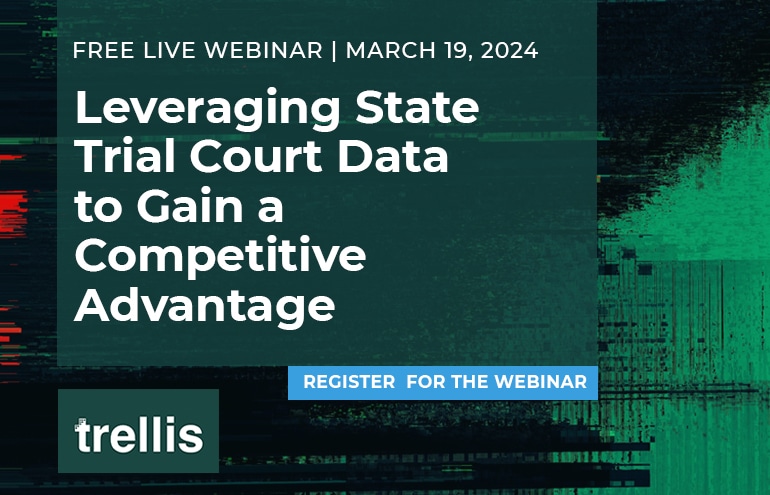Your law firm’s ability to leverage state trial court data boosts your business and competitive intelligence capabilities to a new level. Here’s a primer.

As I write these words, the United States Supreme Court is hearing oral arguments for Moody v. NetChoice and NetChoice v. Paxton, a pair of social media cases expected to profoundly shape online speech’s future. While these two cases may be pivotal in our (re)interpretation of the First Amendment, most legal casework flies under the radar, far beneath the public’s notice. Approximately 41,000 civil lawsuits are filed daily in the United States, with 97% of these cases circulating at the circuit and county level. This represents a veritable goldmine of information about the litigation process.
How can attorneys harness the power of big numbers to enhance their business and competitive intelligence?
What Is Business Intelligence?
Simply stated, business intelligence is the business of law. It encompasses the analytical skills required to secure new business opportunities and retain existing clients. Each law firm must know its position within the market.
- How does your practice stack up against other law firms?
- What practice areas or matter types highly saturate your book of business?
- Who are these clients?
- Is it worth consolidating your specializations?
- Or should you expand into another sector?
The need for answers to these questions has only intensified. Over the years, the budgetary pressures on corporate legal departments have sharpened, pushing in-house counsel to minimize the costs of external law firms. Law firms must be prepared to showcase their worth to current (and prospective) legal departments, demonstrating with concrete figures the (potential) value-added whenever they (might) address a company’s legal needs.
Legal analytics platforms parse through state trial court data in ways that help law firms answer these questions and track how they have changed over time.
What Is Competitive Intelligence?
Competitive intelligence refers to the practice of law. It’s how attorneys evaluate cases, research legal issues, and design case strategy. Rather than focusing on market growth and business development, competitive intelligence delves into the nitty gritty details of an individual law firm’s motion practice performance.
Some of this intelligence can be presented through quick, aggregated insights. However, the juiciest bits are embedded within the underlying data — the cases and the documents powering legal analytics. By studying this underlying data, attorneys can learn about a competitor’s prior cases, dispositive motion grant rates, and common paths to case resolution. We can see the sources of case law towards which our opposing counsel tends to turn. We can highlight the patterns in their settlement strategy.
In short, we can learn to think like our opponents, predicting their every move.
Related Reading: “Using How Attorneys Can Use Legal Data for Business Development and Intelligence.”
Leveraging State Trial Court Data for Legal Intelligence
Imagine, for a minute, that I’m a senior partner at a medium-sized law firm, representing businesses in various types of torts throughout California. I am subscribed to a legal analytics platform, which has provided me with a litigation insights report of a major social media company. The report presents detailed information on 231 cases in which the company was a party between 2018 and 2023. Nearly 90% of those cases took place in California, with roughly 80% involving tort law. As I flip through the pages, I also learn that 56 different law firms have defended the company over the years, most of which have done so no more than one or two times. In fact, the law firm most frequently selected to defend this social media company has only done so 16 times.
This has me thinking: Who is this law firm that has represented this company the most? Could there be room for my firm within this company’s book of outside counsel?
Analyzing potential client companies and their law firms gives you a strategic advantage
As I return to my legal analytics platform, I am met with a dashboard that allows me to study the litigation landscape through the lens of a specific firm — either my own or a competitor. In this anonymized, hypothetical example, I can see that the social media company’s preferred defense firm primarily represents clients in California and Texas, with its practice heavily concentrated in tax matters. If I dive a little deeper, I learn that the firm has expanded its torts practice within the past year, creating a situation where its torts cases now far outweigh its tax cases. By deepening my study of this firm’s newly blossoming tort practice, I can search for past cases on point, which allows me to identify the individual attorneys assigned to those cases and read the actual motions they have filed with the court.
These are the kinds of details I might want to remember if I decide to pitch my firm’s services to this social media company. They are also the kinds of details I might want to remember if I ever come across this firm as opposing counsel.
Small Details, Big Pictures
The two cases pending before the United States Supreme Court have the potential to radically alter how social media companies regulate content on their platforms, pushing the highest court in the land to make decisions about the scope of our First Amendment protections. As legal scholars reflect on the questions these two key cases raise, I want us to remember the millions of cases that never make the headlines. After all, it’s the mundane and unremarkable cases that have the largest impact on the litigation landscape, all of which, when combined, evince the power of big numbers.
When our legal analytics are fed thousands of cases, deviations get smoothed out and patterns begin to emerge, shifting our thinking away from stories about unique actions and moving them towards the frequent, the recurrent, the common. As legal analytics platforms continue to refine their data, we are witnessing profound transformations in the levels of internal insights they afford, with data being finessed for presentation in increasingly novel ways. That is to say, our understanding of the litigation landscape is no longer constrained by the limitations of empirical data.
Now, more than ever, it’s merely the boundaries of our own creativity that are shaping the development of best practices for business and competitive intelligence.
Questions? Join Our Live Webinar on How to Leverage State Trial Court Data
Register for the upcoming webinar, “Leveraging State Trial Court Data for a Competitive Advantage,” presented by Attorney at Work and Trellis, the AI-powered research platform.
To learn more about law firm analytics, visit www.trellis.law.

Image © iStockPhoto.com.

Don’t miss out on our daily practice management tips. Subscribe to Attorney at Work’s free newsletter here >






















